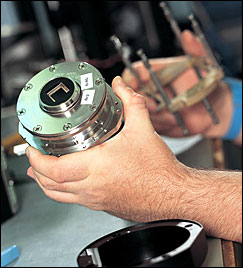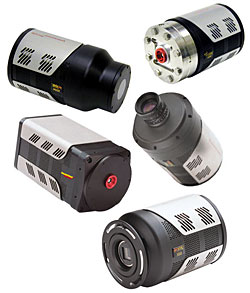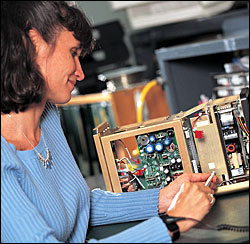
PI/Acton: A Pioneer in Light Detection
TRENTON, N.J., Aug. 1, 2006 -- Princeton Instruments/Acton (PI/Acton), a manufacturer of high-performance light detection systems for spectroscopy, imaging, x-ray surveillance and laser optics applications, has released a number of revolutionary technologies from its Trenton-based facility over the years.
 One such innovation, a spectroscopy detector technology dubbed "hybrid sensor technology" (HST), combines the benefits of both a CMOS with CCD sensor technology for optimized sensitivity and speed and can achieve thousands of spectra-per-second at subelectron readout noise.
One such innovation, a spectroscopy detector technology dubbed "hybrid sensor technology" (HST), combines the benefits of both a CMOS with CCD sensor technology for optimized sensitivity and speed and can achieve thousands of spectra-per-second at subelectron readout noise.
PI/Acton provides expert engineering.
The HST provides nearly 100 percent quantum efficiency and negligible dark current with virtually unlimited dynamic range, as well as a non-aging sensor technology with the ability to take true quantitative measurements.
In addition to the HST, PI/Acton has pioneered a variety of new technologies, including the TriVista for Raman spectroscopy applications, which captures Raman spectra as close as 3 cm -1 from the Rayleigh line with a grating selection allowing wavelength coverage from 200 nm to 2.2 µm. PI/Acton also developed the SpectraPro HRE echelle spectrograph, which uses a prism to separate multiple orders of diffraction from the echelle grating while capturing the wavelength range with the vertical image plane of the CCD, and the PIXIS, a high-resolution deep-depletion CCD with back-illumination and excellent performance in the near-infrared region.

Next-generation cameras featuring permanent vacuum with all-metal seals and the lowest dark current using TE air cooling
PI/Acton has nearly four decades of expertise in spectroscopy and imaging. Before merging with the Acton Research Corp. in 2005, Princeton Instruments manufactured several state-of-the-art CCD cameras, such as the world's first spectroscopy camera to include a photodiode array and the first high-performance, gated, intensified CCD camera in 1995. It was also the first company to package and use EMCCD technology for scientific applications which "[pushed] the boundaries for high-speed, low-light experimentation," according to a company press release.
Acton Research Corp., based in Acton, Mass., also developed a variety of breakthrough technologies before joining Princeton Instruments, such as vacuum ultraviolet (VUV) coatings and optical filters for analytical and aerospace applications in the 1960s and laser mirrors for excimer laser manufacturers in the 1970s. Launched in 1978, the company's spectroscopy business was the first to produce vacuum and UHV spectrometers for government and research laboratories.
Now a fully unified corporation under Roper Industries, PI/Acton has geared its knowledge and expertise toward enhancing product development through customer feedback.
"PI/Acton realizes that its customers are its future," said Antoinette O'Grady, the company's chief scientist. "We believe in listening to what customers have to say and developing products that match their needs."

PI/Acton offers proficiency in manufacturing
O'Grady said PI/Acton maintains regular contact with its customers in order to continuously improve product quality according to their specified demands. O'Grady, who was PI/Acton's first female chief scientist, received her BS in chemistry and an MS in analytical chemistry from the University of Cork, Ireland. Later, she received a PhD in physical chemistry from Queen's University in Belfast. Her expertise lies in a variety of applications, including Raman spectroscopy and CCD technology, which she has applied to a variety of applications, such as spectroscopy, x-ray and imaging.
Her largest contribution to the company so far has been the establishment of a scientific advisory board to assist in the development of a technology roadmap to meet the future needs of PI/Acton's target markets. The board consists of some of the world's top scientists.
O'Grady said she hopes to develop even closer relationships among PI/Acton and members of the scientific community.
For more information, visit: www.piacton.com
/Buyers_Guide/Teledyne_Princeton_Instruments/c12186